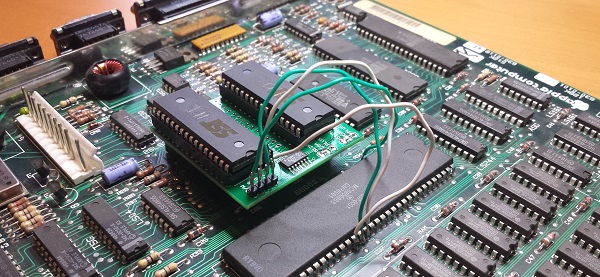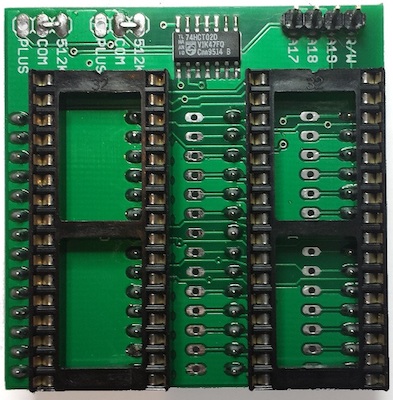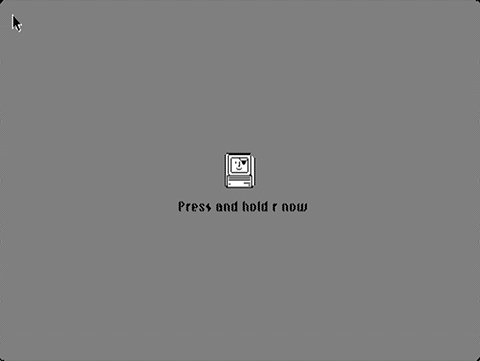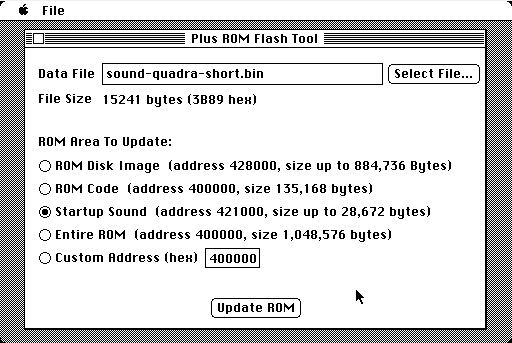Introducing the Mac ROM-inator


Today I’m excited to introduce a new product: the Mac ROM-inator kit. The ROM-inator replaces the stock 64K or 128K of ROM in a compact Macintosh with a full 1 MB of flash memory, unlocking wild new possibilities. Add and edit a bootable ROM disk! Replace the startup sound, or tweak the ROM code behavior. What’s best is the flash ROM’s contents can be updated from within the running Macintosh, allowing for crazy customization experiments. For power users, binary editing of the ROM image opens new possibilities like changing the Happy Mac icon, altering the built-in fonts, and modifying the system startup routines.
The Mac ROM-inator supports the Macintosh Plus, Mac 512Ke, 512K, and 128K. The kit includes two preprogrammed flash memory chips, with a System 6 ROM disk and a “mooo” startup sound. It’s priced at $25, and is available immediately. Get yours now!
The ROM-inator is a descendant of Rob Braun’s original Mac Plus ROM Adapter and disk driver. More details about its inspiration and development are here.
Usage
When first powered on, the Macintosh will play a customized startup sound, and display a “pirate Macintosh” icon. To boot from the ROM disk, press and hold the R key on the keyboard for a few seconds. If R is not pressed, the Macintosh will boot normally from an attached SCSI disk, or wait for a floppy disk to be inserted.

The 1 MB flash ROM includes 132K for ROM code, 28K for a custom startup sound, and up to 864K for a ROM disk image. The preprogrammed flash chips contain ROM code based upon the Mac Plus ROM. If used with a Macintosh 128K or 512K, it will turn them into a 128Ke or 512Ke. This will also give those machines native HD20 support, for use with Floppy Emu in HD20 hard disk emulation mode.
The utility program Flash Tool can update the flash ROM from within the running Mac. Alternatively, the flash chips can be removed from their sockets and reprogrammed using a standard EPROM programmer.

To use Flash Tool, simply select the ROM area and the data file to use for the update. The program will verify that the data file is the correct size for the area to be updated. After about sixty seconds, it’s done!
Read 5 comments and join the conversation5 Comments so far
Leave a reply. For customer support issues, please use the Customer Support link instead of writing comments.


I hope that’s the same “moooo” we heard in Tetris Max 🙂
Oooh! Sadly it’s not, but that’s a great idea. I still have that moo somewhere…
Congratulations! Makes me want to add a Mac Plus to the collection!
Silly question: Several sources show that the memory map for the 128K and 512K has a huge gap above $4FFFFF, and another source ( http://www.retro.co.za/ccc/mac/ReverseEngineering/PALs.htm ) claims that the entire 4 MiB range from $400000-$7FFFFF is decoded for boot ROM on these first Macintoshes. Is this accurate, and does this mean it’s possible for a 4 MiB ROM? Does it pose a problem for something else? Obviously whether it’s practical is another question altogether…
It’s complicated, and I’ve lost my earlier notes about it, but the 128K and 512K combine two different methods of ROM enabling. A PAL does some partial address decoding and is connected to ROM chip enable, but another one of the address lines is connected directly to the ROM’s output enable pin. Or maybe I’ve got those backwards. But either way, just looking at the address decoding in the PAL doesn’t tell the whole story. As I recall, there are also huge address ranges that will enable multiple chips at once, and cause bus conflicts, if accessed by the CPU. Not the most robust design.
I’d say it’s theoretically possible to have a larger flash ROM, but not practical. For one thing, there are no larger flash ROM chips that come in DIP-32 packaging. You’d need to use more flash chips, which means adding still more chips to decode which of the flash chips to enable for a given address. And the address decoding would start to get weird, and require more CPU address bus connections. 1 MB just falls out as an “easy” amount of ROM expansion given the Mac’s design.